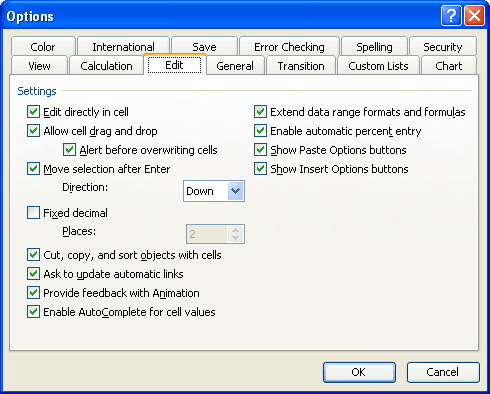Please Note: This article is written for users of the following Microsoft Excel versions: 97, 2000, 2002, and 2003. If you are using a later version (Excel 2007 or later), this tip may not work for you. For a version of this tip written specifically for later versions of Excel, click here: Moving Cells Using the Mouse.
Written by Allen Wyatt (last updated April 27, 2024)
This tip applies to Excel 97, 2000, 2002, and 2003
As you edit your worksheet, you can use the mouse to move cells from one location to another. You do this by following these steps:
If there is anything already at the target location, Excel may ask you if you want to overwrite the existing cells. You can respond according to your desires.
If you cannot seem to edit this way, or if no heavy border (step 2) appears around your selected range, then drag-and-drop editing is probably turned off on your system. To check this, follow these steps:

Figure 1. The Edit tab of the Options dialog box.
ExcelTips is your source for cost-effective Microsoft Excel training. This tip (2648) applies to Microsoft Excel 97, 2000, 2002, and 2003. You can find a version of this tip for the ribbon interface of Excel (Excel 2007 and later) here: Moving Cells Using the Mouse.

Best-Selling VBA Tutorial for Beginners Take your Excel knowledge to the next level. With a little background in VBA programming, you can go well beyond basic spreadsheets and functions. Use macros to reduce errors, save time, and integrate with other Microsoft applications. Fully updated for the latest version of Office 365. Check out Microsoft 365 Excel VBA Programming For Dummies today!
Do you need to paste formulas without updating the references in whatever you are pasting? You can accomplish this, ...
Discover MoreHave you ever spent a lot of time putting information into a worksheet, only to realize that you should have put it in ...
Discover MoreIf you want to turn a range of cells by 90 degrees within a worksheet, you need to understand how Excel can handle the ...
Discover MoreFREE SERVICE: Get tips like this every week in ExcelTips, a free productivity newsletter. Enter your address and click "Subscribe."
There are currently no comments for this tip. (Be the first to leave your comment—just use the simple form above!)
Got a version of Excel that uses the menu interface (Excel 97, Excel 2000, Excel 2002, or Excel 2003)? This site is for you! If you use a later version of Excel, visit our ExcelTips site focusing on the ribbon interface.
FREE SERVICE: Get tips like this every week in ExcelTips, a free productivity newsletter. Enter your address and click "Subscribe."
Copyright © 2026 Sharon Parq Associates, Inc.
Comments